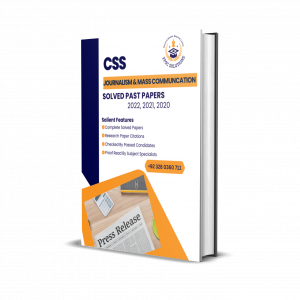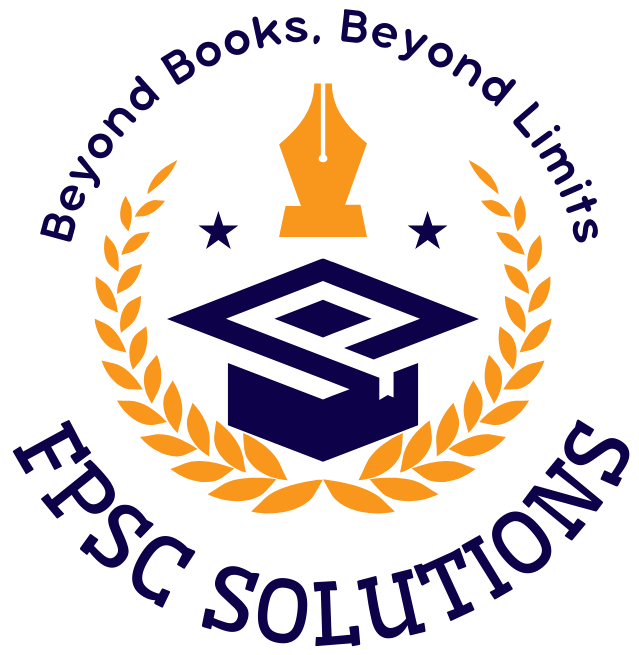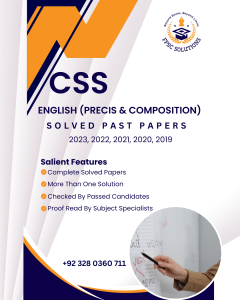The Central Superior Services exam in Pakistan is competitive exam to recruit civil servants for various government departments. This exam is a pathway to esteemed government positions in Pakistan, offering a stable career while serving the nation. CSS Journalism and Mass Communication is an elective subject in the exam that allows candidates to show their knowledge and skills in the field of media and communication. While they face the challenge of mastering complex topics and understanding exam patterns.
Past paper solutions for CSS Journalism Mass Communication Papers 2024 are valuable resources that provide insights into the exam pattern, question types, and effective strategies for scoring well. These solutions and preparation material can help aspirants identify their strengths, weaknesses, and areas for improvement, ultimately enhancing their chances of success in the CSS exam.
This article provides a breakdown of the 2024 CSS Journalism Mass Communication questions, guiding students on how to develop strong, well-supported essays that align with the exam’s requirements.

CSS Journalism Mass Communication Past Papers 2024
Q1. To what extent does the Magic Bullet theory retain relevance in the context of the digital social age? Provide supporting examples to illustrate its applicability or limitations in today’s media landscape.
Q2. Assess the current state of Freedom of Expression in Pakistan, outlining the primary challenges it faces, Explore the potential societal impacts of these challenges on Pakistan’s future, and propose measures to address these concerns.
Q3. Critically examine the impact of cultural imperialism on contemporary communication practices globally. Discuss how dominant cultures influence the communication landscape and assess its effects on preserving cultural diversity and indigenous identities.
Q4. What is the significance of Public Relations departments for both Government and Private organizations? Provide examples.
Q5. Describe the importance of Development Support Communication in Pakistan’s progress. Discuss its methods, and difficulties, and share examples.
Q6. What ethical issues do media professionals face in the digital age? Offer solutions to maintain ethical standards in the digital media age for media professionals.
Q7. Write a note on any two of the following:
- Digital Divide and Access to Information
- Fake News and Disinformation
- Two-step flow model.
Complete Solution with Citation for CSS Journalism and Mass Communication
-

CSS JOURNALISM MASS COMMUNICATION SOLVED PAST PAPERS 2024, 2023, 2022, 2021, 2020
₨ 999 – ₨ 2,999Select options This product has multiple variants. The options may be chosen on the product page
CSS Journalism and Mass Communication Victory Started Here
Q1. To what extent does the Magic Bullet theory retain relevance in the context of the digital social age? Provide supporting examples to illustrate its applicability or limitations in today’s media landscape.
To address the relevance of the Magic Bullet Theory in today’s digital social age, start by explaining the theory’s basic premise—that media messages have a direct and immediate impact on audiences. Then, assess how this theory holds up in the context of modern media, where social media and digital platforms have changed the way information is consumed. Provide examples of both the applicability and limitations of the theory. For instance, discuss how viral content on social media can spread rapidly, reflecting the Magic Bullet Theory, while also noting the more complex interactions between media and audiences today.
Q2. Assess the current state of Freedom of Expression in Pakistan, outlining the primary challenges it faces, Explore the potential societal impacts of these challenges on Pakistan’s future, and propose measures to address these concerns.
When evaluating the state of Freedom of Expression in Pakistan, begin by outlining the current challenges, such as censorship, legal restrictions, and threats to journalists. Explore how these issues affect Pakistani society, potentially stifling dissent and limiting access to information. Propose measures to improve the situation, like strengthening legal protections for journalists and promoting media literacy. Support your points with relevant examples and logical arguments to illustrate the potential societal impacts and solutions.
Q3. Critically examine the impact of cultural imperialism on contemporary communication practices globally. Discuss how dominant cultures influence the communication landscape and assess its effects on preserving cultural diversity and indigenous identities.
In examining the impact of cultural imperialism on global communication practices, explain how dominant cultures influence communication norms and practices worldwide. Discuss how this can lead to the overshadowing of local cultures and the erosion of indigenous identities. Use examples to illustrate how global media conglomerates may shape cultural perceptions and communication standards, and analyze the consequences for cultural diversity. Argue for the importance of preserving local cultures amidst global influences.
Q4. What is the significance of Public Relations departments for both Government and Private organizations? Provide examples.
For an essay on the importance of Public Relations (PR) departments, describe how PR functions benefit both government and private organizations. Use examples to illustrate the role of PR in managing public perception, handling crises, and maintaining positive relationships with stakeholders. Highlight how effective PR strategies contribute to an organization’s success and reputation.
Q5. Describe the importance of Development Support Communication in Pakistan’s progress. Discuss its methods, and difficulties, and share examples.
Discuss the importance of Development Support Communication in Pakistan’s progress by defining it as the use of communication strategies to promote development goals. Describe methods used, such as public campaigns and community outreach, and identify challenges like resource limitations and resistance to change. Share examples of successful communication initiatives in Pakistan, such as health awareness campaigns, to illustrate their impact on national development.
Q6. What ethical issues do media professionals face in the digital age? Offer solutions to maintain ethical standards in the digital media age for media professionals.
Address the ethical issues media professionals face in the digital age, such as issues of privacy, misinformation, and the spread of fake news. Offer practical solutions to maintain ethical standards, like implementing stricter fact-checking processes and promoting transparency in digital media practices. Discuss how these solutions can help media professionals navigate the complexities of modern media ethics.
Q7. Write a note on any two of the following:
- Digital Divide and Access to Information
- Fake News and Disinformation
- Two-step flow model.
For the notes section, provide a concise overview of two topics:
Digital Divide and Access to Information: Explain the gap between those who have access to digital technologies and those who do not. Discuss its implications for information access and how it affects different populations.
Fake News and Disinformation: Describe what constitutes fake news and disinformation, and discuss their effects on public perception and trust in media.
Two-Step Flow Model: Outline the Two-Step Flow Model, which suggests that media messages are first filtered through opinion leaders before reaching the broader audience, and discuss its relevance to modern communication.


